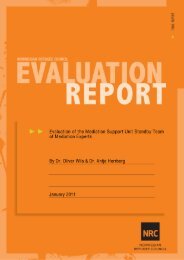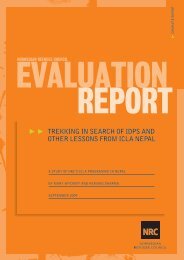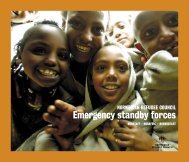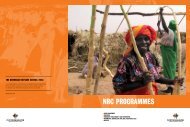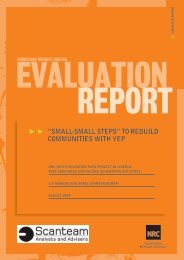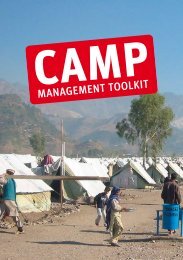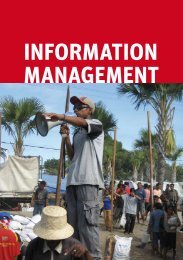evaluation of general food distribution in northern uganda: gulu ...
evaluation of general food distribution in northern uganda: gulu ...
evaluation of general food distribution in northern uganda: gulu ...
Create successful ePaper yourself
Turn your PDF publications into a flip-book with our unique Google optimized e-Paper software.
Up until 2005 most people received a 74% or 98-100% rations depend<strong>in</strong>g upon the capabilityto compliment the distributed <strong>food</strong> aid with <strong>food</strong> items from own sources. In 2006 the rationswere reduced. In Gulu and Amuru the reduction was 40%, 50% and 60% <strong>of</strong> the full ration forNon Extremely Vulnerable Individuals (NEVIs) and for the Extremely Vulnerable Individuals(EVIs) 98%. In Kitgum the rations were reduced to 60% for NEVIs and ma<strong>in</strong>ta<strong>in</strong>ed at 100%for the EVIs.Table 4: Food rations and ValuesFoodrationCerealkg/person/monthPulseskg/person/monthVeg. Oilkg/person/monthCSBkg/person/monthFoodValue/day100% 12,5 2,1 0,6 2,1 2100 kcal98% 12,45 2,1 0,6 1,5 2054 kcal74% 8,4 1,8 0,37 1,8 1554 kcal60% 7,2 1,2 0,45 - 1259 kcal50% 4,5 1,8 0,36 - 1050 kcal40% 4,5 0,9 0,3 - 828 kcalAs shown <strong>in</strong> the table with the exception <strong>of</strong> EVIs, most allocated <strong>food</strong> ration s do not amountto the m<strong>in</strong>imum nutritional and dietary standard <strong>of</strong> 2.100 kcal per person per day, theassumption be<strong>in</strong>g that IDPs will manage to secure the rema<strong>in</strong><strong>in</strong>g <strong>food</strong> -gap themselves.Furthermore it is argued that IDPs compliment their diet with other fo od aid <strong>in</strong>terventionsfrom WFP such as Food for Education (school feed<strong>in</strong>g), Therapeutic Feed<strong>in</strong>g Centres (<strong>food</strong>for babies and lactat<strong>in</strong>g mothers) and Food for Work (<strong>food</strong> <strong>in</strong> exchange for manual labour).7.1.3 Employ<strong>in</strong>g the Fair Share ‘Family Size Model’In order to ensure that each household was secured equally with <strong>food</strong>, NRC employed a newmethodology <strong>of</strong> <strong>food</strong> <strong>distribution</strong> <strong>in</strong> 2003, described as the ‘family size model’. Until thenNRC had been us<strong>in</strong>g a model, where <strong>in</strong>dividuals with a ration card would receive the sam erations regardless <strong>of</strong> their family size. This resulted <strong>in</strong> an unfair <strong>distribution</strong> <strong>of</strong> rations, wherea family <strong>of</strong> one person would receive the same amount <strong>of</strong> <strong>food</strong>, as a family <strong>of</strong> 12 persons.With the ‘family size model’ <strong>food</strong> rations are given accord<strong>in</strong>g to the number <strong>of</strong> people <strong>in</strong> eachhousehold, which eventually leads to all <strong>in</strong>dividuals receiv<strong>in</strong>g the same amount. It took sometime before the new model was understood and the organisation <strong>of</strong> the <strong>distribution</strong> performedas <strong>in</strong>tended. Once this was <strong>in</strong> place the results were clear: households were receiv<strong>in</strong>g theirfair share <strong>of</strong> <strong>food</strong> <strong>in</strong> an organised way 67 . Moreover, NRC handed over the physical<strong>distribution</strong> activity <strong>of</strong> scoop<strong>in</strong>g to the beneficiaries themselves and the FMCs. In groupsbeneficiaries carry their sacks and divide scoops <strong>of</strong> the different items between them. IDPsappreciate be<strong>in</strong>g actively <strong>in</strong>volved because as one women said: “its our <strong>food</strong>, why should weleave it to somebody else to serve for us” 68 . In order to ensure that NEVIs do not disturb theEVIs this group is served separately.7.1.4 Have Beneficiary Needs & Demands been met?NRC monitors its contribution to household security and the ma<strong>in</strong>tenance <strong>of</strong> nutritional anddietary standards (‘Objective 1’) through daily, monthly and quarterly reports, post distributio nmonitor<strong>in</strong>g reports and participation <strong>in</strong> <strong>food</strong> security and nutritional surveys. Some <strong>of</strong> theconsistent f<strong>in</strong>d<strong>in</strong>gs on the quantity and quality <strong>of</strong> <strong>food</strong> dur<strong>in</strong>g the past three years <strong>in</strong>clude 69 :Regard<strong>in</strong>g the <strong>food</strong> basket composition, its usage and quality: Beneficiaries expressed<strong>general</strong> satisfaction with the <strong>food</strong> basket as a temporary <strong>in</strong>tervention – particularly when itwas complete, i.e. with all the <strong>in</strong>tended <strong>food</strong> items. This <strong>food</strong> basket comb<strong>in</strong>ed with thesupplementary feed<strong>in</strong>g programmes <strong>in</strong> feed<strong>in</strong>g centres and <strong>in</strong> schools was appreciated by67Key <strong>in</strong>formants from Kitgum and Gulu Districts, WFP Gulu and OCHA Kitgum.68Focus group discussion with IDPs <strong>in</strong> Amida camp.69 NRC monthly and quarterly monitor<strong>in</strong>g reports + Post Distribution Monitor<strong>in</strong>g Reports from 2005 to 2008 + <strong>in</strong>terviews/focusgroup discussions with male and female IDPs (EVIs and NEVIs) <strong>in</strong> Amida camp, Pawidi Transit site, Opit camp, OrafwoyoTransit site, Lukwor Transit site, Acet IDP camp, Amuru IDP camp.26





